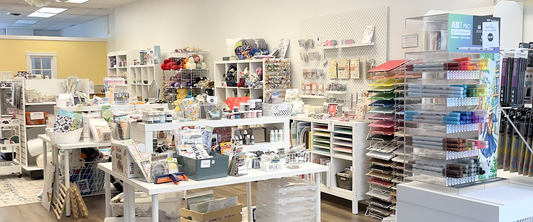I am always astounded by the quality of the donations we receive. People are SO happy to see their once-loved supplies go to someone who will care for them and ensure they are put to good use by a fellow creator. A middle-man reseller like a creative reuse center or traditional thrift store is a much-needed service.
That said, it’s also completely understandable that you want to recoup the expense with some items. It’s not so easy to let a nearly-new Cricut machine with all of the accessories go without wanting some compensation!
If you have some big ticket items, like a Cricut, easel, light table, mat cutter, or a collection of antique buttons, you might be asking, where can I sell my art supplies? How do I find a buyer for the collection? And, should I sell them all together or separately, and where?
This article should help answer all of your questions! I’ve been a reseller since 2010 and have had countless experiences buying and selling in various places and situations. I’ve put all of that experience together here. Below are my tried and true options for passing your art supplies along to others, with the pros and cons of each method and tips for figuring out pricing.
Where to Sell
Garage Sale
Hosting a garage sale can be a great way to move many items out of your home, but there are some tricks for a successful sale.
- First, you need a garage or front yard. If you live in a large multifamily building, a garage sale most likely isn’t the best option for you unless you organize your neighbors and management and host a building-wide sale in the parking lot or lawn.
- Price low. Don’t expect to get anywhere close to retail for what you’re selling. The standard percentage for garage sales is 10% of retail.
- Clean up your items. The cleaner and more organized the sale, the better the sales.
- Don’t go it alone. Try to host your sale when there are lots of other sales happening in your area. This can be through an organized city-wide or neighborhood sale. If this isn’t an option, you will need lots of signage to promote your ad on Craigslist and other garage sale listing sites.
Selling Art Supplies Grade = D. A garage sale is designed for quickly moving out unwanted items at low prices. If the goal is to get top dollar, there are better places to sell your expensive items.
Consignment
Many great consignment shops are available in-person and online; however, most are for clothing and accessories or household items like furniture. If you’re hoping to consign art and craft supplies or collectibles, you’ll have to make inquiries. Some resellers will take items on consignment if it’s a good fit, a high-dollar item, and will sell quickly.
- Antique, second-hand, specialty (comic book, jewelry, etc.), and online resellers may be willing to take your items on consignment, but you usually have to ask.
- Consignment works best for single items where your agreement with the reseller is opened and shut on one sale, not collections where things will sell best one at a time and over a longer period of time. Tracking these small sales and payouts is not ideal.
- Expect to get 40-50% of the sale price. The consignor has the upfront costs of renting, staffing, and advertising - all of which bring their buyer to your item. The reseller may also need to mark the item down to get it to move.
- Many resellers will take consignment items, even if they don’t advertise the service (like Hello Art Hatchery!).
Selling Art Supplies Grade = A. Your items will be well showcased, and the seller will be motivated to get top dollar. You’ll be supporting a local small business and should get the best possible price you can without the hassle of selling it yourself.
Auction & Estate Sales
The companies that run auctions and estate sales will often take items in a consignment fashion and will add your items to another person’s sale. You won’t get a lot of control over what the item(s) sell for, but you can ask for a reserve/minimum amount. Expect to pay the sale company at least 50% of the sale price.
Selling Art Supplies Grade = C. Your items won’t get much love, and you won’t have much control over how much you’ll make, but you will support a local small business and the reseller market.
Craigslist
Craigslist gets a bad rap due to scammers, which is a real threat. However, Craiglist has also been around for a long time and can be a great way to connect with buyers. You’ll want to read up on how to protect yourself, but most of the time, as long as you’re cautious, transactions will be legitimate. Again, you won’t get top dollar selling on Craiglist, but you can avoid the middleman and get more than you will if you consign. You’ll still need to price yourself under retailers, however. Second-hand and vintage sold one-to-one without a storefront will always sell for less.
Selling Art Supplies Grade = B. Be safe and patient; you can do well on Craigslist. Price high and wait for the right buyer; most will want to negotiate. If your item isn’t moving, drop the price and repost it.
Facebook Marketplace
Marketplace is an alternative to Craiglist and is the preferred selling platform in many regards. You can’t sell on Facebook with a new account, and sellers can view the buyer's profile to check for markers of legitimacy. However, you’ll still want to be careful and educate yourself on potential scams. Like Craiglist, you won’t get top dollar, but you can get close with Marketplace if you have a high-demand item and are patient.
Selling Art Supplies Grade = A-. Watch for scammers and wait for the right buyer. Offer shipping or delivery for more reach. You’ll have to do the legwork of photographing, listing, and fielding inquiries, but what you earn will be all yours.
Reseller
Reselling secondhand as a business is extremely popular right now. You're most likely dealing with a reseller when you see items selling for top dollar in second-hand spaces like Poshmark, Mercari, Etsy, eBay, Google, or Amazon. They find items at thrift stores, garage sales, auctions, and estate sales or are pickers like on the History Channel show, American Pickers. Do some searching on these websites to find resellers to work with. They will buy your items outright but will need a markup, so expect to get less than retail.
Selling Art Supplies Grade = B-. Finding a reseller can take a bit of legwork, but if you find one, it can be worth the effort as it’s an immediate sale that won’t get dragged out over time.
Once you select the method you’ll use to sell your items, you’ll want to search to find a fair price.
Finding a Fair Price
First, you need to research pricing for similar items:
- Take a good picture of the item you want to sell and use Google Lens to reverse search. Find all the listings for items like yours and determine who the seller is and where they fit in the “where to sell” categories earlier in this article.
- Facebook Marketplace and Craigslist won’t appear in Google, so check those two sites using keywords that match the item.
- It’s also worth checking Etsy and eBay specifically, even though they may appear in Google searches.
You’ll see lots of listings that are way out of the realm of reality. Just because someone prices an item at $100 doesn’t mean it’s worth $100. Inexperienced resellers can have VERY inflated ideas of value. Be reasonable, look to find the average, and ignore the high outliers. If possible, try to find what things actually sold for. Etsy will show you this information, and some paid sites like Worthpoint will also.
Differentiating Factors
Item condition informs value, don’t compare a mint item to your worn one. Some colors and patterns are more desirable, and black and white are usually worth less. Original vs. reproduction matters, so check copyright dates if they are available. The material also matters: a skein of antique silk embroidery thread is not the same value as a skein of cotton thread of the same age.
If you can’t find anything similar to yours, try to find and join collector or reseller groups on Reddit or Facebook, where you can post a picture, and people with more experience will help you determine a fair price.
There are many ways to find a new home for the items you’re ready to let go of, but they all involve a level of legwork and involvement on your part. In general, what you gain in ease, you lose in profit! In summary:
- If you’re a DIY type, try Marketplace or Craiglist, and skip the low prices of garage sales.
- If you want someone else to handle the logistics, choose consignment or an estate/auction company.
- If you want something in the middle of these two, try finding a reseller.
And, if you don’t want to do any of this, donate the item to your local creative reuse center or thrift store! Whatever you do, don’t shove it back in a closet, and don’t put it out with the trash. Someone out there wants to use what you no longer need. Get it back into circulation!





